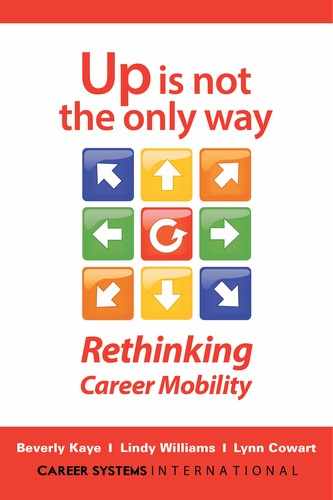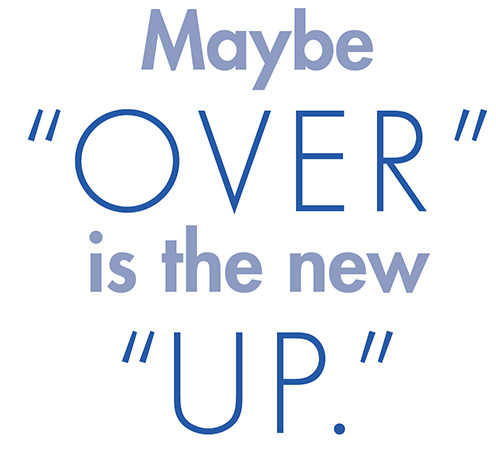![]()
Do you know how to do everything your teammates can do? If you traded places with a peer in another group, could you hit the ground running?
Teams are everywhere, in every industry and every organization we work with today. Movement among teams is more fluid than in the past and offers terrific opportunities to grow. Lateral experiences build breadth of expertise—something senior leaders need and value. The person who gets hands-on experience in multiple areas learns functional interdependencies and gains a deeper understanding of just how the organization works.
Years ago, lateral moves carried a subtle warning message. In fact, the accepted political whisper was that if your organization moved you laterally more than three times, they were sending you a coded message that your career was going nowhere! Lateral experiences no longer carry that message. Sideways moves no longer sideline talent. Instead, as the title of this chapter suggests, lateral moves can lead to bigger and better opportunities. People who can fulfill multiple roles build resilience and position themselves as valuable resources in a changing environment.
Picture that kaleidoscope we talked about earlier. To change a kaleidoscope pattern, the beads in the tube shift by a turn of the tube to the left or the right. And that movement, however slight, has a tremendous effect on what we see. Career patterns can transform in the same way, through even small moves to the left or to the right. Moving to the left or the right can expand capabilities and multiply opportunities for growth.
Fit to a T
MOBILITY MOMENT
Move Over
During interviews we conducted while writing this book, we asked people to share their feelings about lateral career experiences. We heard about expanding breadth of expertise and learning about different areas of a business or industry. One answer stood out for us, however. One individual shared that, when she looks back on her career, she now realizes how quickly the time passed. She offered this advice to those just starting on their career patterns: “Don’t become married to just one path. Be open and explore alleyways you didn’t imagine for yourself.” In her journey, moving laterally several times enabled her to gain hands-on experience, using skills and developing capabilities that she would have missed had she proceeded straight up the rungs of an organizational ladder.
IDEO, a leading global design firm headquartered in San Francisco, views intense cross-disciplinary project work as core to innovation. Other organizations have capitalized on IDEO’s idea of developing the “T person.” This individual has more than just depth of knowledge (the stem of the T) in a discipline or expertise. They also have a solid grasp of cross-functional systems (breadth), connections, and collaborative skills—adding the top line that makes a T. This combination of depth and breadth enables them to reach across boundaries and address issues that require a broader view. These individuals often step in as the innovators and systems thinkers within an organization.

Lateral moves feed the appetite of T talent by offering chances to broaden understanding, diversify knowledge of the organization and the industry, and practice those collaboration skills. Oh! And lateral experiences don’t hurt visibility, either! In fact, people who choose purposely and plan fully to have lateral experiences create new ways to market their personal brands and grow a solid network of connections.
But Wait! Why Should I Do This?
Sometimes, the most challenging part of planning lateral experiences is uncovering and examining what’s holding you back. Some thoughts that get in the way are discussed here—with ideas for rethinking each one. See which ones might be standing in your way. Read through the responses and watch for at least one I never thought about it like that before in your thinking.
It’s perfectly understandable for these objections to exist. It’s important to think through how the responses above might help you view lateral experiences in a different light. We recognize that it may not be politically correct to voice them as openly as we just did. In a conversation about lateral possibilities, a brave leader might just give voice to those thoughts by asking, “What are you thinking? How would a lateral experience work for you?” Having the courage to put reservations on the table openly and honestly just may result in one or more of the I never thought about it that way before! ahas.
Organizations are clearly moving toward more and more horizontal movement. Conversations that examine the value of lateral experience might be the first step toward shifting a mind-set and making sideways moves career advancing and enhancing.
What Goes Around Comes Around
A manager Bev met on a plane told her this story:
An employee of mine—someone I really liked—offered to help another function of the company. The function needed her specific skill set. I told her I didn’t mind as long as she continued to meet her goals in my department. We arranged for her to spend 20 percent of her time with the other function and the remaining time working in her current job. It felt like a win–win. She would get development and the other function would get the help they needed.
In the end, she found she so enjoyed the other role that she did not want to return. Of course I was sad to lose her, but I knew it was the best move for her. And I knew I would eventually find a replacement. As it turned out, in just a few weeks the manager in the other function recommended someone who was the perfect replacement! So it was even more of a win than I expected.
Are We Selling Laterals?
Here’s a new way to look at lateral experiences. And it’s not just an attempt to make something undesirable look better. It is about having a full appreciation for what a sideways move could provide. Maybe “over” is the new “up.” In fact, many studies report that people are in search of personal growth opportunities that promise purpose and fulfillment—the money-and-meaning balance—and not necessarily just a promotion or a bigger paycheck. Here are some truths that we found, and questions you can use to generate conversations about lateral experiences.

Of course, as with any options, there are cautions about lateral experiences. Organizational grapevines can be skewed against this opportunity, even if you select it as best for your career pattern. Accepting a lateral opportunity without having passion or interest in it can lead to a career dead end. And, quite frankly, every new experience brings the chance of failure. Although many say “Fail first, fail fast, learn from failure,” it can also be a stumbling block that is very difficult to overcome. Examine the positives and the downsides. Weigh all the pros and cons and have conversations to determine how and if the pluses outweigh the minuses before making any move. Only you can determine whether an experience is right for your career pattern.

When the Rung Disappeared
An operations manager recently shared with Lynn her story about lateral experiences.
Throughout her career, the manager had continuously pursued the next rung on the ladder. The unwritten norm in her organization was that if you didn’t move up every couple of years, your career was slipping away. As the company delayered, though, the only opportunities were lateral moves—and even those options were outside of operations. Considering a staff role had never been on her radar. After the pace of operations, areas like finance, marketing, or human resources seemed less than exciting.
However, she took the step sideways. In fact, she took several. And she found that there were whole new worlds to learn. When she eventually accepted a promotion back in operations, she was selected because she now had a breadth and depth of expertise that few others could replicate.
She feels the lateral experiences led her to make decisions in her day-to-day role that are grounded in a broader view of the overall organization. She now has firsthand experience in how other functions operate and what’s important to delivering successful results across the departments.
* Have you taken a lateral move in your career? What was the upside? The downside?
* What other areas of the organization could use your current skill set?
* Which of your abilities and capabilities can most easily be applied and/or transferred to another area?
* What gets in the way of considering a lateral move?
* How will you determine whether a lateral experience is right for you?
. . . TALK ABOUT IT







